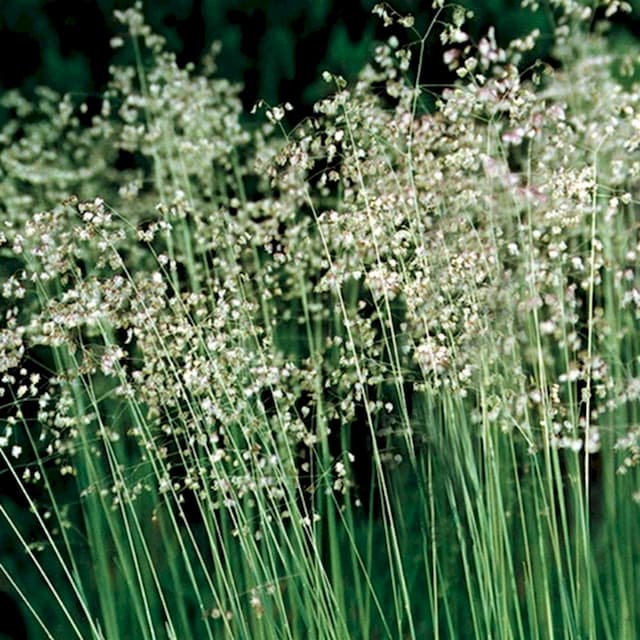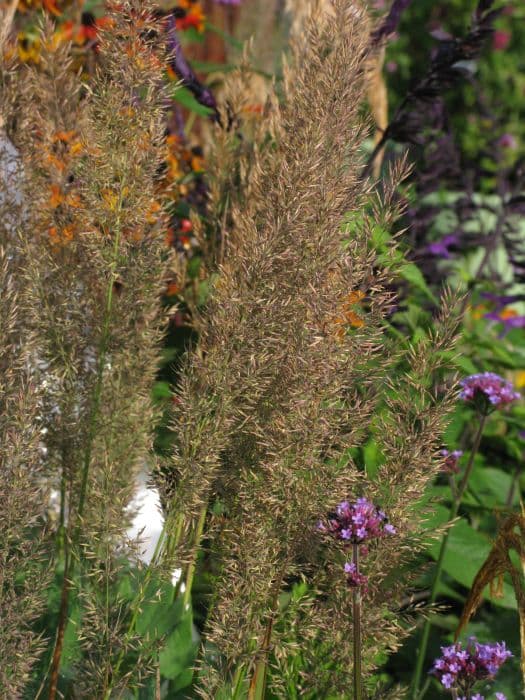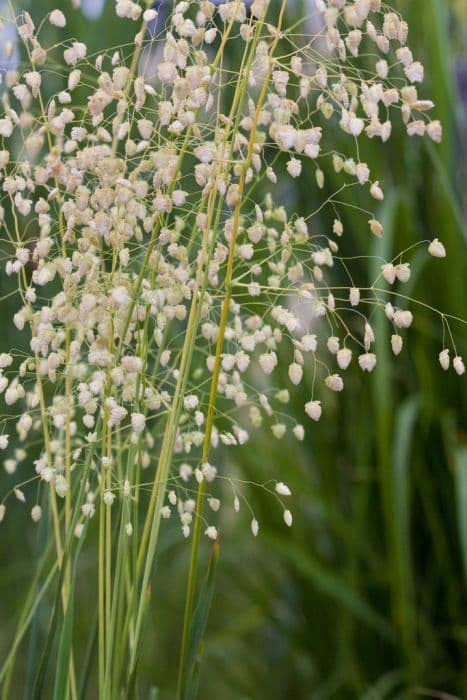Mexican feather grass Stipa tenuifolia Steud.

ABOUT
Stipa tenuifolia, commonly known as Mexican Feather Grass, sports a delicate and feathery appearance. The plant bears a fine-textured foliage that is bright green in color, creating a soft, wispy presence in the landscape. Its narrow leaves cascade gracefully and sway with the slightest breeze, adding movement to the setting they adorn. During the blooming season, the plant is adorned with airy, hairlike flowers that emerge on slender stalks above the foliage. These flowers give the plant a halo-like effect and can add a golden hue as they mature. The overall look of Mexican Feather Grass is that of an elegant, flowing tuft that brings a sense of lightness and fluidity to any space it inhabits.
About this plant
 Names
NamesFamily
Poaceae.
Synonyms
Mexican Feather Grass, Pony Tails, Angel Hair, Silky Thread Grass, Texas Needle Grass.
Common names
Stipa pennata L. subsp. tenuifolia (Steud.) St.-Yves, Stipa capillata L. var. tenuifolia (Steud.) Hook.f., Stipa tenuissima Martinovský.
 Toxicity
ToxicityTo humans
Stipa tenuifolia Steud., commonly known as Mexican Feather Grass, is generally not considered toxic to humans. However, as with many ornamental grasses, it is not intended for consumption. If ingested in large quantities, it could potentially cause mechanical irritation or blockage in the digestive tract due to its fibrous nature. There is no well-documented evidence of chemical toxicity in humans from ingesting Mexican Feather Grass.
To pets
Mexican Feather Grass, the most common name for Stipa tenuifolia Steud., is not known to be toxic to pets. However, ingestion of grasses by pets can sometimes lead to gastrointestinal upset, such as vomiting or diarrhea. The physical structure of the grass can cause irritation to the stomach or intestines. Also, in rare cases, if large amounts are ingested, it could potentially lead to an obstruction, which might require veterinary attention. It's important for pet owners to monitor their pets and ensure they do not consume large quantities of this or any other non-food plant.
 Characteristics
CharacteristicsLife cycle
Perennials
Foliage type
Deciduous
Color of leaves
Green
Height
2 feet (60 cm)
Spread
1 foot (30 cm)
Plant type
Herb
Hardiness zones
4
Native area
Europe
Benefits
 General Benefits
General Benefits- Erosion Control: Stipa tenuifolia, commonly known as Mexican Feather Grass, helps prevent soil erosion due to its fibrous root system that holds soil in place.
- Drought Tolerance: Mexican Feather Grass is highly drought-tolerant once established, making it suitable for xeriscaping and arid environments.
- Low Maintenance: It requires minimal upkeep once established, with no need for regular watering, fertilizing, or mowing.
- Aesthetic Appeal: Mexican Feather Grass adds a soft, feathery texture and movement to gardens, with its graceful foliage swaying in the breeze.
- Habitat for Wildlife: It provides shelter and nesting materials for birds and small mammals, as well as a habitat for beneficial insects.
- Adaptable: This grass is capable of growing in a wide range of soils, from sandy to clay, which makes it versatile for different landscape uses.
- Seasonal Interest: Mexican Feather Grass offers visual interest throughout the seasons, from its green growth in spring to golden tones in autumn and winter.
- Fire Resistance: When maintained properly and kept hydrated, it can be part of fire-resistant landscaping due to its high moisture content.
 Medical Properties
Medical PropertiesThis plant is not used for medical purposes.
 Air-purifying Qualities
Air-purifying QualitiesThis plant is not specifically known for air purifying qualities.
 Other Uses
Other Uses- Decorative arrangements: Stipa tenuifolia, commonly known as Mexican feather grass, is often used in dried flower arrangements due to its delicate, feathery plumes that add texture and movement.
- Thatching: In some regions, Mexican feather grass can be utilized for thatching roofs of traditional or rustic structures due to its long, sturdy stems.
- Erosion control: Planting Mexican feather grass on slopes can help reduce soil erosion, as its root system helps hold the soil in place.
- Ground cover: This grass can serve as an attractive ground cover in landscaping, filling in spaces between other plants and providing a soft, flowing aspect to garden beds.
- Photo shoots: Due to its ethereal and whimsical appearance, Mexican feather grass is often used as a backdrop in photography, especially in portrait and fashion shoots.
- Sensory gardens: It can be included in sensory gardens, where its fine texture provides a tactile experience, especially when caressed by the wind.
- Film and theater sets: Mexican feather grass can be used on stage or in movies to create realistic outdoor scenes or to invoke specific atmospheres, such as a prairie or meadow.
- Living fences: When planted in rows or clusters, this grass can form a semi-permeable living fence, adding privacy and a natural aesthetic to the landscape.
- Wind indicator: The light and feathery composition of the plant makes it ideal for use as a natural wind indicator in gardens or open fields.
- Wildlife habitat: Although not a primary use, the dense bunches of Mexican feather grass can provide shelter and nesting materials for small wildlife and insects.
Interesting Facts
 Feng Shui
Feng ShuiMexican Feather Grass is not used in Feng Shui practice.
 Zodiac Sign Compitability
Zodiac Sign CompitabilityMexican Feather Grass is not used in astrology practice.
 Plant Symbolism
Plant Symbolism- Resilience: Stipa tenuifolia, also known as Mexican Feather Grass, is a hardy plant that can withstand various conditions, symbolizing the ability to endure and thrive through adversity.
- Gracefulness: The delicate and feathery appearance of its foliage represents grace and finesse, often used to convey an air of elegance in gardens.
- Simplicity: Its simplistic and unassuming form can symbolize the beauty in simplicity and the importance of a minimalist approach to life.
- Movement: The way Mexican Feather Grass moves with the wind can symbolize flexibility and the ability to sway harmoniously with the rhythms of life.
- Connection with Nature: As a plant that blends well with many natural landscapes, it can represent a deep connection with the natural world and environmental awareness.
 Water
WaterMexican Feather Grass (Stipa tenuifolia Steud.) prefers to be watered deeply but infrequently, allowing the soil to dry out between waterings. During the growing season, water approximately once every week or two, depending on weather conditions, providing about 1 to 1.5 gallons of water per plant each time. In the winter, reduce watering to once a month or less, as the plant is dormant and requires much less moisture. Overwatering can lead to root rot, so ensure proper drainage and avoid letting the plant sit in soggy soil.
 Light
LightMexican Feather Grass thrives in full sun conditions, requiring at least 6 to 8 hours of direct sunlight daily for optimal growth. It can tolerate some light shade, especially in hotter climates, but its foliage might not be as dense. The ideal spot for this plant would be in an open area with unobstructed access to sunlight, away from taller plants that might shade it throughout the day.
 Temperature
TemperatureMexican Feather Grass can survive in a wide range of temperatures, from around 20°F to 100°F. However, this grass prefers temperatures between 60°F and 80°F for optimal growth. It is a hardy plant and can survive occasional dips below freezing. Ensure it's planted in an area without prolonged exposure to temperatures below 20°F.
 Pruning
PruningPrune Mexican Feather Grass (Stipa tenuifolia) to remove old, brown foliage and encourage fresh growth, typically in late winter or early spring before new shoots appear. Cut the grass back to about 4 to 6 inches above the ground. Pruning should be done annually, and it's the best time to shape the plant and tidy up its appearance while minimizing the chance of disease taking hold in the old material.
 Cleaning
CleaningAs needed
 Soil
SoilMexican feather grass, also known as Stipa tenuifolia, thrives in well-drained soil with a mixture of sand, loamy soil, and some organic matter. The ideal soil pH for Mexican feather grass is neutral to slightly alkaline, ranging between 6.6 and 7.8.
 Repotting
RepottingMexican feather grass, commonly known as Stipa tenuifolia, is a perennial that does not require frequent repotting. It typically should be repotted only if it outgrows its container or every 2-3 years to refresh the soil.
 Humidity & Misting
Humidity & MistingMexican feather grass, known as Stipa tenuifolia, prefers a dry to average humidity level. It is drought tolerant and does not require high humidity to thrive.
 Suitable locations
Suitable locationsIndoor
Place in bright light, limit water, use well-draining soil.
Outdoor
Full sun, well-drained soil, tolerate drought, minimal care.
Hardiness zone
7-11 USDA.
 Life cycle
Life cycleStipa tenuifolia Steud., more commonly known as Mexican Feather Grass, starts its life cycle as a seed which germinates in favorable conditions of light exposure and temperature. During the seedling stage, the plant begins to establish its root system and sprouts thin, feather-like leaves. As it enters the vegetative growth stage, Mexican Feather Grass develops a fuller cluster of fine leaves and begins to mature, focusing on photosynthesis and root growth. Once mature, it enters the reproductive stage, producing delicate, airy inflorescences that rise above the foliage on slender stalks, and these inflorescences contain the flowers which are wind-pollinated. Following pollination, seeds are produced and dispersed by wind or animals, allowing the plant to propagate and start the life cycle anew. Throughout its life, Mexican Feather Grass is a perennial, dying back to the ground level during the cold season and regrowing from the same root system each year.
 Propogation
PropogationPropogation time
Spring to summer
Stipa tenuifolia, commonly known as Mexican Feather Grass, is often propagated through seed sowing. The best time to propagate by seeds is late spring to early summer when the soil temperature has warmed. To propagate Mexican Feather Grass, you should first collect seeds from the mature plumes once they've dried on the plant. These seeds can be directly sown into a well-draining soil mix. Scatter the seeds on the soil surface, and lightly press them into the soil but do not cover them completely as they need light to germinate. Keep the soil moist until germination, which typically occurs within two to three weeks. After the seedlings have developed several true leaves, they can be transplanted to their final growing position, ensuring they are spaced to accommodate their mature size.









